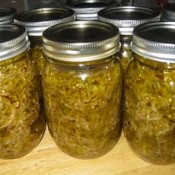Melanzana Marinata (Marinated Eggplant)

The fall season is finally here…and now is the perfect time to put all of your harvest (or whatever veggies you purchase at the store) to good use! I would always look forward to this time of year, when my grandmother would marinate and jar eggplants. It would be put to especially good use around the holidays when my grandfather would add it to his famous hot pepper salad. I decided to start marinating and jarring eggplant myself a few years back and have now made it a tradition that I look forward to every year. It’s not nearly as labor intensive and time consuming as jarring your own tomato sauce (something I still haven’t done yet!), but there is still some quality time and effort involved. As a time-saver, I now shred the eggplant in the food processor instead of slicing. I also think it makes for easier serving. Whatever method of slicing you prefer will work well. However, after all of the slicing, shredding, straining, boiling and packing (and a few precious months of aging), you will be guaranteed instant gratification. The eggplant works great as a topper on eggs, pizza, sandwiches, cutlets, pasta, bread…you name it! It also makes for a nice, from-the-heart holiday gift, as the jars will be ready for serving just after Thanksgiving, if you decide to do the jarring by mid-late September. Give it a try…you’ll be sure to impress!
Melanzana Marinata (Marinated Eggplant)
6 lb. eggplants
2 1/2 tbsp. salt
3 c. white vinegar
2 c extra-virgin olive oil, plus more for topping off jars
6 cloves garlic, peeled & sliced
2 tbsp. dried oregano
1/4 tspn red pepper flakes
4 pint-size glass canning jars (often called mason jars) and 2-piece metal canning lids
Rinse and peel eggplant. Either a) shred the eggplant in a food processor, or b) cut into 1/4 inch lengthwise vertical slices, then cut slices into lengthwise 1/4 inch french fry-size strips. Place the shredded/sliced eggplant into a nonreactive (plastic or stainless) colander and toss with salt. Place a plate on the eggplant and place a weight (several large cans of tomato sauce works well) on the plate. Let colander stand in the sink for 2 hours, so that bitter eggplant juices drain away. Place colander under running cold water and rinse eggplant quickly. After rinsing the eggplant, take a handful at a time and squeeze out all the excess water from it.
Put the eggplant in a bowl with the vinegar and marinate it for 30 minutes (it will return to shape like a wet sponge). Drain the vinegar from the eggplant and squeeze it dry again. Put the eggplant into a bowl with 2 cups olive oil and remaining combined ingredients.
Wash 4 pint jars with hot, soapy water and rinse thoroughly. Then, gently immerse the jars into a large pot of boiling water, turn down heat and let simmer for 10 minutes. Carefully remove jars with tongs. Fill jar with eggplant mixture to within 1 inch of top. Ladle oil into jars, filling them to within 1/2 inch of the top. Wipe rims of jars with a clean, damp cloth, as residue may not allow for lids to seal properly. Immerse lids (flat disc portion only – not the ring part) into hot, but not boiling, water. Remove and press lids onto top of jars. (NOTE: Some lids have different preparation steps, so closely follow the lid manufacturer’s directions for heating time). Screw rings onto cool jars.
At this point, you can place the jars in a pot of boiling water for a few minutes, making sure that the jars are fully immersed. This will help seal the jars.
Allow jars to cool undisturbed for 24 hours. During cooling, you might hear a soft “ping” when the lids seal tightly. Once the jars are cool, test for vacuum seals by tapping the top of the jar with a spoon. You should hear a bell-like tone, not a “clunk.” Also, the lids should be concave; a convex lid is a sign of a bad seal. Finally, the lids should not move when you press on them with your finger. Refrigerate the jars that did not seal properly. (Resealing jars after they have cooled isn’t safe.)
Store the jars in a cool, dark place, such as a cupboard or a basement for at least two months prior to opening. Once the jar has been opened, keep it in the refrigerator.
For complete tips on jarring, please visit http://www.exploratorium.edu/cooking/pickles/canning.html



Recent Comments